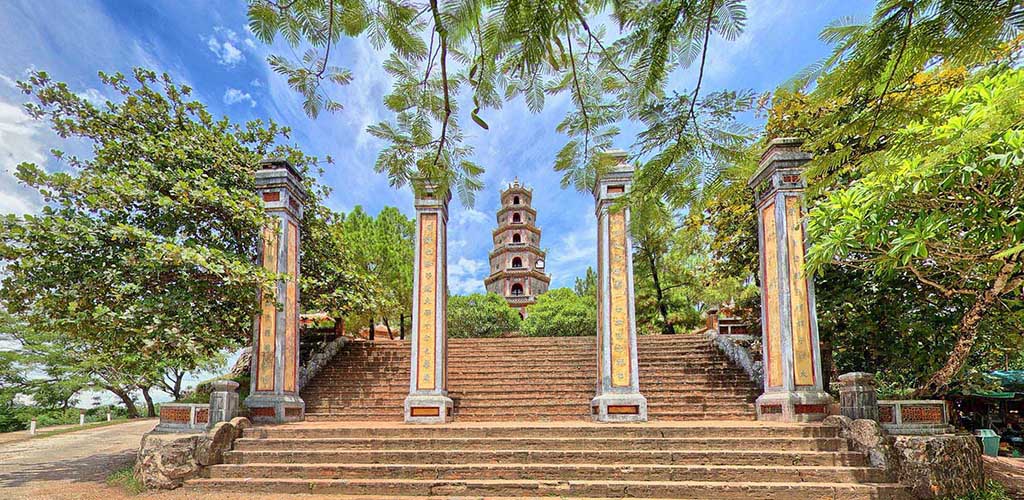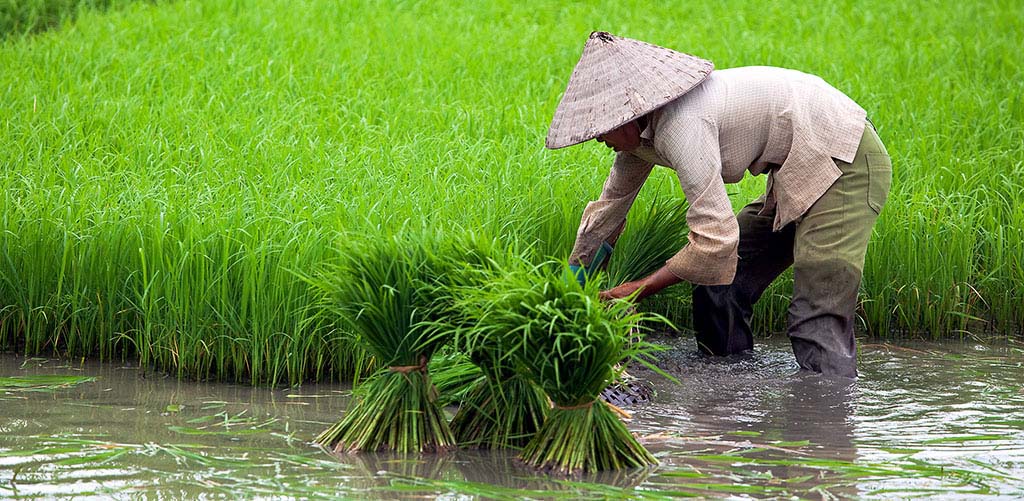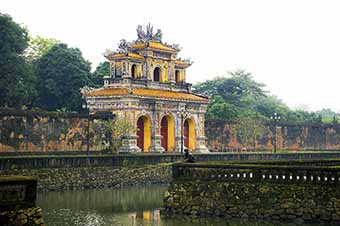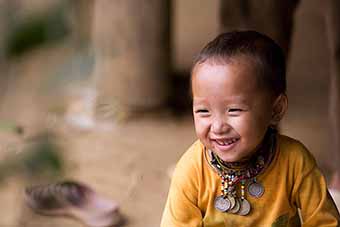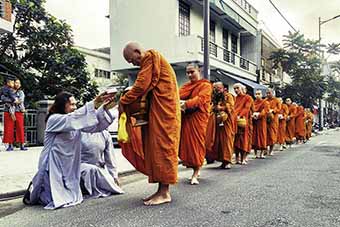Most travelers skip or breeze through sleepy Hue mostly missing out on the exceptional charms of Vietnam's most beautiful town. Unlike most other places in Vietnam, having a some background knowledge about the "Imperial capital" before arrival along with the very special places, people encounters, and activities we've arranged, Hue will be one of your favorite memories of Vietnam.

Located on the Vietnam's central coast roughly halfway between Hanoi and Saigon, Hue is Vietnam's most picturesque and pleasant city. While Danang, only an hour to the south, succumbs to over development of industry, resorts, shipping, and into air transport gateway, Hue remains the cultural, religious, and educational heart. The landscape here-with its misty Perfume River and pagodas has served as inspiration for poetry and painting. Hue has also long been regarded as the "Third Capital" of Vietnam, after Hanoi, the political one, and Saigon, the commercial one.

Indochina Travel's Hue Favorites
- Most travelers miss what makes Hue Vietnam's most pleasant and beautiful city. The setting and countryside are one of a kind as are the people, more serious, determined, educated and independent than any other in Vietnam.
- As with other parts of the country, distinctive cuisine featuring delicious banh mi (sandwich), banh xeo, and "bun bo Hue" — Hue's spicy version of pho.
- Cruising on the pleasant Perfume River, which divides the town in half
- Cycling the countryside. Hue features some of the most beautiful landscapes from emerald green ride fields, river views, and white-sandy lagoons. These landscapes make cycling in Hue a must, even for leisurely rides, is exceptional here with gentle traffic and lovely country roads and village footpaths.
- Mandarin homes—wooden relics from another time. Perhaps a bit too popular in recent years, it is nonetheless a rare, historic structure where one can also dine on delightful Hue favorites.
- Kindergarten visit, a delightful experience especially with children.

- Military tanks and cannon. These are the only few in the entire country, a surprise for most travelers who may pass through the entire country and never know the war took place. Look for scars of battle in the Citadel walls as well, Hue was the only city to experience fighting during the war.
- Sunset drinks atop a rooftop bar. High, panoramic views provide a perspective of Hue few others see.
- Hue combines well with Hoi An, 99 miles to the south, the overland drive passing through landscapes of beaches, lagoons, farms, and villages (cycling can be arranged)

Highlights of the Hue, The Imperial City
Imperial Tombs

A highlight of visiting Hue are the imperial tombs are scattered in the countryside four to eight miles south of Hue, but we will start our visit in Hue on the south bank, passing where the old French quarter was once located. The tree-lined avenues around Le Loi Boulevard are great places to appreciate the history of the city. Along the waterfront was prime French real estate: in the north, the Customs House; between the two bridges, the Circle Sportif, official residences, and colonial villas; to the south, the French-constructed railroad bridge. The tombs themselves are relatively modern but one should visit at least the most impressive pair, Khai Dinh and Tu Duc.
Hue Citadel — A Royal Legacy

Emperor Gia Long modeled the Royal Citadel on the Forbidden City in Beijing, China. The ramparts, however, were built in the style of French military architect Sebastian de Vauban. The complex had fallen into neglect even before it was all but blown to pieces by the fighting of 1968 (it was partially destroyed during fighting with the Vietminh in 1947). With much of the structural work made of wood, it fell prey to rain, typhoons, and termites, as well as thieves.

The front gateway and several important structures within the Imperial Palace grounds have been restored; beyond these, it's mostly ruins in poor shape though restoration began in earnest in 2012.
Museum of Royal Fine Arts
This museum, just east of Hien Nhon Gate. Housed in a former royal palace, the museum's collection of antique furniture, bronze ware, screens, ceramics, musical instruments, and royal clothing give we a real feel for the mandarin period though exhibits are unlabeled.

Thien Mu Pagoda

Thien Mu on the banks of the Perfume River. This Mahayana Buddhist temple is a peaceful place to spend time. It's the oldest monastery in Hue, dating back to the 17th century. Near the front stands seven-tiered Phuoc Nguyen Tower, long the symbol of Hue. It was built in 1844, each level containing an altar dedicated to a different Buddha. Near the tower are several smaller buildings; one holds the temple's massive bell Cast in the early 18th century, the bell. weighs several tons. In another pavilion is a marble turtle; stele mounted on it chronicle the development of Buddhism in Hue.

Activities in Hue
A river runs through the heart of Hue, inspiring wonder, compelling you upstream. On the first leg of your journey, a cyclo ferries you to the Noon Gate of the Imperial City. You marvel at the ambitions of the Nguyen Emperors, and their grandiose designs. Their palaces, temples and galleries evoke a world that feels partly real but mostly fantastic. Further upstream, your sense of wonder deepens at the foot of one of Vietnam’s most iconic monuments, the tower at Thien Mu Pagoda. Now you’re wondering whether you haven’t stumbled into the dream-world of an East Asian landscape painting.
At the tomb of Emperor Minh Mang, you’re sure of it, here among pavilions, stele, courtyards, gates, ponds and gardens. Your appetite is sated... but not yet, not quite. Back at the art-deco splendor of La Residence, there is a Kir Royal aperitif to be had on the hotel’s terrace. And then, as evening falls over the tranquil Perfume River, you sit down amidst frangipani and silk-cotton trees for a repast inspired by colonial era traditions. You delight in each flavor, as privileged by this singular culinary experience as the Emperors of Old Hue.
Perfume River Dinner Cruise
Depart from La Residence Hotel towards Thien Mu Pagoda, champagne in the sunset followed by sumptuous dining in style with a delicious signature menu. This is a 2 ½ hour cruise departs at 18:30 and returns at 21:00.
A Taste of Hue Cooking Class
Depart to Hue local market by cyclo to experience the unique variety of local fresh food produce; back to the hotel, our Chef will guide your hand into creating some of the most traditional family dishes influenced by Hue gastronomic history.
Thien An Hill Picnic Lunch
The cool pine forest canopy of Thien An Hill awaits you for a bespoke picnic lunch. A relaxing break to unwind after a morning threading through Imperial Citadel and Tombs of Hue.
Vietnamese Cupping Therapy
This traditional massage using special pressure point techniques combined with relaxing effleurages will awaken live energy, improve & refresh blood circulation as well as eliminate tightness or fatigue from stiff muscles.
Vietnamese Poolside BBQ
Absorb the serenity of the gardens and the cool Perfume River breeze. This informal BBQ concept is perfect for that family get-together or a romantic dinner you have both been waiting for.

Cycling Hue
Vietnam's most beautiful city reveals itself even more by two wheels, with a leisurely spin out to the Imperial Tombs through village footpaths and past rice paddies, returning along the river. For the more adventurous, we can ride through the town and ancient citadel.
La Residence Degustation
Discover our sophisticated seven-course degustation menu complimented with a selection of wines. This memorable and romantic dining experience will be arranged for you & your special one at the most elegant surroundings of Le Parfum restaurant. Contact our restaurant team for menu reference and arrangement (Note: a six-hour advance booking is typically required).
An Dinh Culinary Delight
Step back in time, experience our culinary delight catered at one of the most seductive historical addresses in Hue. An Dinh Palace is once residence of King Bao Dai and his mother Queen Tu Cung during the 1920s. This themed dinner is available for group from 10 persons & a 24-hour advance booking is required

Artists in Hue
Truong Be, a longtime artist and gentle presence in Hue, creates modern take on lacquer painting is modern and bold. Please ask us to arrange a visit to his gallery.
Meet with talented artist Vo Xuan Huy in his private home to learn about the process and materials used into making Vietnam’s traditional lacquer paintings, an art unique to Vietnam. Also joining the family for dinner featuring delicious traditional Hue home cooked dishes with this charming, intellectual couple and their adorable children.
Meet with archaeologist Mr. Tran Dinh Son, a leading expert and collector of ceramic wares, cooking utensils, and other relics from the feudal dynasties dating back from over a thousand of years including the Ly Tran kingdoms. Mr. Son’s great, great grandfather who was the most important mandarin in Vietnam, ranked only after the king and Mr. Son will explain the mandarin system which existed for hundreds of years.
New Space Arts Foundation is new organization founded by two young Vietnamese artists is an independent art space in Hue to give a long overdue boost the contemporary art scene in the city, which typically remains in the shadow of Hanoi. NSAF provides financial support to young Vietnamese and space to exhibit their work.
Hue Architour
Hue is home to splendid, well-preserved imperial architecture including numerous tombs scattered throughout the surrounding hills, the massive Citadel, and buildings in the Forbidden Purple City.

Discover Hue's architecture with Mr. Phan Thanh Hai, an architect and Director of Hue Royal Monuments Preservation and Renovation Institution. Mr. Hai will lead a visit Thieu Tri and others structures largely unknown and off-limits to visitors, including Ho Quyen, the only coliseum in Southeast Asia and secondary royal tombs. We will learn about the materials and process used to preserve and save these ancient Royal structures.
Other Activities

Hue is one of the best locations for cycling. We've organized cycling tours since 1993 through our adventure wing VeloAsia, the very first company to do so in Vietnam, and Hue was always and still remains a highlight. We can plan for short, leisurely to full-day rides in around the town and beautiful countryside.
Sunset atop the Imperial Hotel. At 16 stories, the rooftop lounge is the highest structure in Hue providing stunning, panoramic views of Hue and the Perfume river. We suggest aperitifs here before heading out for dinner.
Visit Hue’s nursing school, escorted by the head master or his colleagues to learn more about the health care system of Hue and learn about the public health care in Vietnam while meeting with students and teachers.
Culinary
This university city is not known for cuisine as is Hoi An, a mere 99 miles to the south and there are few places to dine of any quality. Native dishes not to miss in Hue are bun bo hue (spicy pho - soup), banh xeo (crepe), banh mi (Vietnamese sandwich, found throughout the country but delicious here), and me xung (a sticky rice treat also found everywhere in Vietnam, but the very best is in Hue).
We can plan a delightful tour and dinner of Mr. Vinh, a royal ancestor who lives in a sprawling traditional mandarin style home with a pleasant courtyard where his family will prepare dining, allowing you to join in the cooking if you'd like. Mr. Vinh has become very popular in recent years, please expect at least a couple of other small groups during your dinner.
Accommodation in Hue
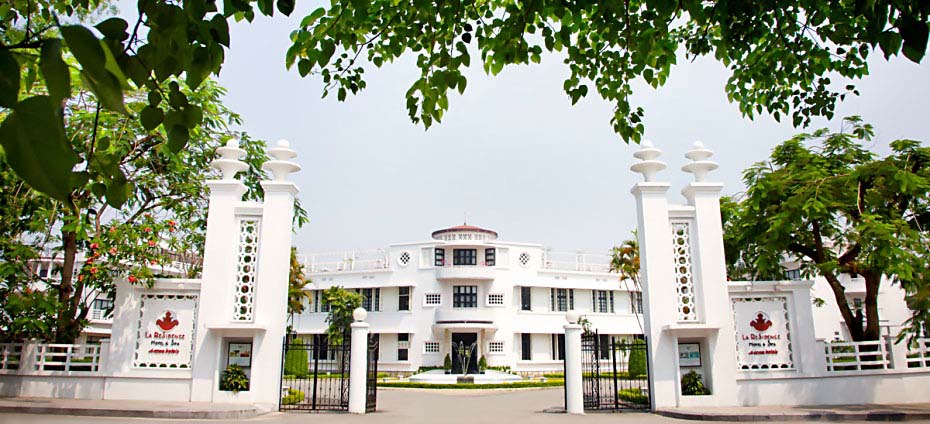
La Residence, an Art Deco oasis, sits on the banks of the Perfume River. Not on par with the Metropole in Hanoi, nonetheless it is Hue's finest hotel with an ideal location and central to all sites. The spacious veranda is pleasant for relaxing and the spa is one of the finest in the country. Although the weather in Hue, If you are biking with us, we can simply pedal out the front gate on our way to the nearby Tu Duc royal tomb.


History of Hue
Hue was the capital of Vietnam from 1802 to 1945, before Hanoi, a royal city under a succession of 13 emperors of the Nguyen dynasty after Emperor Gia Long, founder of the Nguyen dynasty, consolidated the country after several hundred years of civil war, and began building Hue Citadel as his base. Modeled after the Chinese Forbidden City the dynasty ruled from the Imperial City, off limits to most with access only mandarins, princesses, and scholars who resided here. Also in the finest Chinese tradition, the emperors constructed elaborate tombs, scattered around Hue, which will be one the highlights of your visit here.
In 1883 the French invaded Hue and Vietnam became a French protectorate, though the French found it expedient to maintain the illusion of imperial rule with puppet emperors. A rapid succession of these faux emperors marked the early days of French presence as rulers either fled or were replaced in time by the French.
Hue still represents a third political force in Vietnam. During the Vietnam War of the 1960s, educated Hue citizens backed neither the South nor the North. During the Tet offensive of 1968, Vietcong (VC) and NVA forces marched into Hue and held it for 24 days. The soldiers used the Citadel, with its 10-meter-thick ramparts, as their base. During the occupation VC and NVA forces went on a rampage. Suspected sympathizers of the Saigon government were rounded up, then shot, beheaded, or buried alive. It is estimated that 3,000 residents of Hue were killed during those 24 days. we can still see symbols over doorways, indicating where residents were killed. In fierce door-to-door fighting, the Americans eventually ousted the North Vietnamese. An estimated 10,000 people died in Hue during the Tet offensive of 1968. Most were civilians. In the process, the Imperial Palace was reduced to rubble. Today the monuments of Hue are on the United Nations's World Heritage list, so sites may one day be restored. Today Hue is a quiet town of over 350,000. While Saigon and Hanoi grow by leaps and bounds, places like Hue crawl along. Few joint ventures are allowed, and there are few private hotels. Deliberate blocks placed by the central government insist joint ventures in Hue be "branches" of those in Hanoi or Saigon.
Getting Your Bearings
Similar to Paris, Hue is divided by a river, divided into north bank and south bank sections. The north bank is where the Citadel once stood-a huge walled area sealed by moats and enclosing the Imperial Palace. The north bank is now largely a residential area. Formerly the French quarter, the south bank is the commercial sector, with banks, hotels, restaurants, and transport terminals. Three bridges link the two banks over the Perfume River. Two are used by cars and buses; the third is a railway bridge, also used by pedestrians and bicyclists.
Hue's Imperial Tombs
A highlight of visiting Hue are the imperial tombs are scattered in the countryside four to eight miles south of Hue. Optional touring on bicycle, a wonderful way to see Hue's picturesque countryside, can be arranged. We start our visit in Hue on the south bank, where the old French quarter was once located. The tree-lined avenues around Le Loi Boulevard are great places to wander. Along the waterfront was prime French real estate: in the north, the Customs House; between the two bridges, the Circle Sportif, official residences, and colonial villas; to the south, the French-constructed railroad bridge.
Making our way to Ho Chi Minh Museum at the west end of Le Loi, the museum is more propaganda and can skip it if we wish. Nearby Quoc Hoc School, established in 1896, was attended at different times by Ho Chi Minh, General Vo Nguyen Giap, and Ngo Dinh Diem; it would have been a pretty rowdy class if they'd all attended at once. Quoc Hoc is now a coed high school. We then follow Dien Bien Phu Street for a side trip to Ban Quoc Pagoda-an important center of study. There are an estimated 500 monks and nuns in Hue, and upwards of 100 small pagodas. Monk,, from different pagodas assemble here for instruction; Vietnamese students come to study in the tranquil gardens.
Nam Giao is not much to look at now, but it used to be the most sacred site in Hue. Built by Emperor Gia Long in 1802, Nam Giao was composed of three terraces-two square to represent the earth, and one circular representing the sky. A holder of the "mandate of heaven," the emperor would make sacrifices to the heavens here. The area was turned into a monument for fallen North Vietnamese after 1975-a controversial choice of statuary. From Nam Giao, we move onto to the Khai Dinh Tomb, about 30-40 minutes by bicycle if we are riding. we'll pass village life on quiet roads, forested zones, and farmed areas of sugarcane, rice, and vegetable plots. The countryside is the main reason for cycling through-we may find the imperial tombs disappointing.
It may be hard to get excited about the mausoleums of Hue. The Hue emperors, believing they would be accorded as much splendor in their after lives as in their present ones spent their final days directing tomb construction. Some even threatened to execute artisans if their work was not up to standard. The tombs were copied from Chinese prototypes, but do not match the craftsmanship or ostentation of the originals. In fact, the imperial tombs of Hue are quite dull and gloomy, and exude a stagnant air.
Construction followed a formulaic design, although each emperor's deviated in details. The arrangement comprised five key elements: a brick courtyard with stone mandarin guards, horses, and elephants; a pavilion with marble tablets in praise of the emperor, inscribed by his son and heir; a temple for the worship of the emperor and empress; a lotus pond with a viewing pavilion; and, finally, a deep grave. During construction, the emperor used the viewing pavilion to direct operations; after his death, the temple at the site would be regularly visited by the emperor's widows. Although there were 13 emperors in the Nguyen dynasty (1802-1945), only seven reigned until their deaths, accounting for the low number of tombs in Hue.
Khai Dinh's Tomb, a few miles outside Hue, was completed in 1931, and was 11 years in the making. After the grandiose entryway with dragon pillars, the mausoleum itself is an anticlimax. The architecture is an ugly mix of European and Asian, with grimy rows of mandarin guards in the courtyard. Inside the main hall are colorful glass mosaic frescoes; a life-size bronze statue of Khai Dinh, made in France in 1922, is positioned over the actual tomb.
At the village of Ban Lang, 8 miles from Hue, we can take a small ferry across the Perfume River to Minh Mang Tomb. Out on the water we'll see fishing boats, and sampans dredging for sand and rocks. Minh Mang is the finest of the imperial tombs. The attraction here is the harmonious garden with its frangipani and lotus blossoms. Minh Mang reigned 1820-1840; the tomb was constructed after his death by his heir, Thieu Tri. The atmosphere is one of peace and tranquility.
Once back on the east bank, we continue north and if short on time, may skip Thieu Tri and Dong Khanh Tombs — they're not much to look at. However, Tu Duc Tomb, enclosed by walls, features picturesque pine woods and a lakeside pavilion with lotus blossoms where the emperor once fished, listened to music, and wrote poetry — in between strenuous bouts of tomb building. Emperor Tu Duc went a bit overboard with the poetry, inscribing his own stones with praise of himself. Actually, he did this because he had no son to write the script, even though he had 104 wives and numerous courtesans. Tu Due's Tomb was more of a pleasure garden than a tomb: the emperor used it as a second residence, where he indulged in extravagant 50-course meals of incredible delicacies. Tu Duc reigned 1847-1883; the mausoleum was constructed between 1864 and 1867 by a force of 3,000 laborers. More recently, the lakeside pavilion has been restored with the help of UNESCO.
From here, we make our way north to downtown Hue. However, if we're still up for more touring, we can continue over to the north bank, by boat to carry us across to Thien Mu Pagoda.
Hue Sightseeing
The Citadel
Emperor Gia Long modeled the Royal Citadel on the Forbidden City in Beijing, China. The ramparts, however, were built in the style of French military architect Sebastian de Vauban. The complex had fallen into neglect even before it was blown to pieces by the fighting of 1968 (it was partially destroyed during fighting with the Vietminh in 1947). With much of the structural work made of wood, it fell prey to rain, typhoons, and termites, as well as thieves. The front gateway and several important structures within the Imperial Palace grounds have been restored; beyond these, it's mostly ruins in poor shape. Entry to the Imperial Palace area is $5. The north exit gates are not open, but we should be able to enter or exit by the east gate.
The Royal Citadel is composed of three walled enclosures, each within the other-a city within a city. The exterior moated enclosure (Kinh Thanh) encompasses six square kilometers-sufficient for housing the emperor, his family, administrators, bodyguards, and servants. Piercing the outer walls are 10 gates, each reached by a bridge across the moat. Toward the Perfume River is the Yellow Enclosure (Hoang Thanh), with six-meter-high walls about 2.5 kilometers in length. Within this lies the innermost walled section-the former Imperial Palace, or Forbidden Purple City which is undergoing restoration under U.N. auspices as a World Heritage Site. A major restoration effort was mounted in 1995-1996.
The best parts to view are at the southern end, near the Perfume River. Approaching the Citadel we cross a moat by one of two gates, Nhon Gate or Quang Duc Gate. Inside the gates are two groups of cannons. The Nine Cannons were cast of brass in 1803. They're each five meters in length and are named after the four seasons and five elements. They've never been fired; their function is symbolic. Sandwiched between the two entry gates is the massive Flag Tower. The flag of the National Liberation Front flew here for 24 days in 1968.
| The Nguyen Dynasty Gia Long 1802-1819 Minh Mang 1820-1840 Thieu Tri 1841-1847 Tu Duc 1847-1883 Duc Duc 1883 Hiep Hoa 1883 Kien Phuc 1883-1884 Ham Nghi 1884-1885 Dong Khanh 1885-1889 Thanh Thai 1889-1907 Duy Tan 1907-1916 Khai Dinh 1916-1925 Bao Dai 1925-1945 |
Continuing north we come to Ngo Mon, or Royal Gate, where the ticket office is located. This massive gate was built in 1834 during the reign of Emperor Minh Mang. There are five entrances-in previous times, only the emperor was permitted to use the central one. The gate was extensively restored in the early 1990s; climb to the first level for expansive views. Golden Water Bridge, directly beyond the gate, was once reserved exclusively for the emperor's use. Crossing that, we come to Dien Thai Hoa, the Palace of Supreme Peace, where the emperor, seated on a raised golden throne, held official receptions and supervised important ceremonies. On the steps of the palace are nine stone stele, dividing the courtyard into areas of the nine mandarin ranks. Built in 1833, Thai Hoa Palace is one of the best-preserved buildings left in the complex, with magnificent red- and gold-lacquered pillars (repainted during mid-1990s restorations). There's a scale model of the entire site displayed inside the main hall. Behind Thai Hoa Palace are two huge bronze urns from the 17th century decorated with birds, plants, and animals.
From here, walk to the west side of the complex: this easily overlooked section provides the Citadel's main visual interest. In front of elegant Hien Lam Cac Pavilion are the spectacular Nine Dynastic Urns. Cast in bronze between 1835 and 1837, they stand two meters tall and weigh between 1,500 and 2,500 kilograms each. Each is dedicated to a different Nguyen emperor-the central and largest one to Gia Long. The urns are engraved with various designs-landscapes, wild animals, birds, the sun, the moon, and the stars symbolizing the power of the Nguyen dynasty. The craftsmanship is superb. The bronze urns are a must-see within the Citadel. A short distance north of the urns is Mien Temple, Temple of the Generations, built in 1821. It contains altars for worship of 10 Nguyen sovereigns. The temple was restored in the mid-1990s with British assistance, gaining a reinforced concrete base.
Backtracking a bit, north of Thai Hoa Palace is the Imperial Palace, once reserved for the emperor, his concubines, and eunuch servants. Remaining buildings were are in very poor condition. The Hall of the Mandarins and the Royal Library have been partially restored. The government is investing several million dollars to restore Hue's monuments, so this phoenix is rising from the ashes. Financial and technical support has come from UNESCO; Vietnamese scholars traveled to the Oriental Museum in Paris to survey the original plans for construction of imperial buildings.
A good place to exit the Imperial City is by Hien Nhon Gate on the east. Here we'll find Ong Tao II Restaurant, set in a charming courtyard-an ideal place for a drink. If we exit from Hien Nhon Gate, we can continue walking east to the Imperial Museum.
Museum of Royal Fine Arts
This museum is at 3 Le True Street, just east of Hien Nhon Gate. Housed in a former royal palace, the museum's collection of antique furniture, bronze ware, screens, ceramics, musical instruments, and royal clothing give we a real feel for the mandarin period. Exhibits are unlabeled. Also down this way is the Military Museum, with a few stray tanks and other military hardware in the courtyard.
Thien Mu Pagoda
Thien Mu is about three kilometers from downtown Hue, on the banks of the Perfume River. This Mahayana Buddhist temple is a peaceful place to spend time. It's the oldest monastery in Hue, dating back to the 17th century. Near the front stands seven-tiered Phuoc Nguyen Tower, long the symbol of Hue. It was built in 1844, each level containing an altar dedicated to a different Buddha. Near the tower are several smaller buildings; one holds the temple's massive bell Cast in the early 18th century, the bell. weighs several tons. In another pavilion is a marble turtle; stele mounted on it chronicle the development of Buddhism in Hue.
Encased in glass at the front of the nearby temple is a brass statue of a Laughing Buddha, figure with a fat, bare stomach reclining on couch and laughing his bald head off. The Laughing Buddha is the nickname of 9th-century Chinese Zen master Poe-Tai Hoshang, who discovered the "Buddha within himself." Thi highly eccentric monk wandered blissfully through China without any worries. After hi death he was worshiped throughout the Chinese world as a popular hero and a deity of good for tune. Three superb brass statues stand inside the temple: on the left the Buddha of the Past (Amitabha); in the center, the Buddha of the Present (Sakyamuni); on the right, the Buddha of the Future (Maitreya). There is also a smaller Laughing Buddha statue. The Laughing Buddha is sometimes associated with the Maitreya.
At the back of the temple are gardens and nurseries where the dozen monks who live here cultivate vegetables and trees. They collect orchids from surrounding woods to plant at the monastery; we'll see bonsai trees on display. In this area is a shelter displaying the blue Austin in which Thich Quang Duc, a 66-year-old monk from Thien Mu, was driven to Saigon to immolate himself on a street corner on June 11, 1963 as a protest against repression under the Diem regime. Pictures of the scene gained international news coverage. The car is now revered as a sacred relic.
In May 1993, another immolation occurred outside Thien Mu Pagoda. The Buddhist layman's name was not released, and no reason was provided for the suicide. When the abbot of Thien Mu, Thich Tri Tuu, tried to organize a Buddhist funeral for the man, local government authorities intervened, claiming there was no proof he was a devout Buddhist. Several days later, Thich Tri Tuu was forced into a police car; six monks sat down in front of the vehicle in protest and a large crowd of supporters rallied around. The sit-down strike held up traffic for hours in what turned out to be the largest Vietnamese public protest since the Vietnam War. Eventually, the authorities and the abbot were forced out of the car. It was then overturned, and burst into flames.
In November, the abbot and three other monks from Thien Mu were arrested and subsequently sentenced to three- and four-year prison terms after a closed trial without lawyers or witnesses. This imprisonment may be part of a wider issue; the monks were known supporters of Thich Huyen Quang, a dissident Buddhist exiled to a small village due to his protests against government attempts to control Vietnamese Buddhism.
Hue Cathedral
South of downtown Hue on Nguyen Hue Street is Hue Cathedral, completed in 1962. The cathedral is a curious blend of Asian and Western architecture-a recognizable European cathedral, but with an Oriental octagonal steel spire and Chinese-style eaves. The altar is made from marble quarried at the Marble Mountains near Danang.
NORTH BANK
 Perfume Riverfront |
Dong Ba Market, which can be reached by boat, by bicycle, or on foot directly over the Trang Tien Bridge. we can easily spend several hours at the market, with its profusion of women in conical hats engaging in just about every kind of food transaction known to Vietnam. Early in the morning country folk unload their produce at the market steps by the river, and fishermen from the coast bring in fresh seafood. The covered market features a large rice section.
From Dong Ba Market we travel to the Citadel, and then carry on to Thien Mu Pagoda several kilometers to the west. If we backtrack from the pagoda about 100 meters, we'll find a small boat that will deliver we to the south bank again. we can also ride back along the north bank, using the railway bridge to cross the Perfume River.
Thuan An Beach
About 13 kilometers northeast of Hue, Thuan An Beach stretches for several kilometers and features a protected lagoon and South China Sea frontage. Foreigners pay a fee to enter the beach. Get there by bus from Dong Ba Market, or hire a boat for a longer journey. If we want to stay overnight, there is the 12-room Tan My Hotel, a string of villas with tropical gardens.
DINING
Hue is known for banh khoai, a crepe stuffed with bean sprouts, shrimp, and pork, eaten with salad, star fruit slices, and nuoc tuong (sesame and peanut sauce). A variation on this is bun thit nuong, which uses a noodle base. Wash it down with Huda, the local brew (a joint-venture Danish beer). For those with a sweet tooth, a sticky sesame-seed bar called me xung is handmade on the premises at 135 and 137 Huynh Thuc Khang Street, to the east side of the Citadel, along Dong Ba Canal. Hue residents debate which shop produces the superior version. The families have been making the stuff for the last 40-odd years. Phuoc Hung, at 41 Tran Hung Dao St., also sells me xung, plus Chinese-type pastries. Street stalls occasionally have croissants.
Strung along Hanoi Street are a number of noodle houses with cheap and tasty fare. They serve fried rice noodle soup (pho tai), dry noodles (pho kho), and soft-fried noodles. Trung Lam at 7B Hanoi, serves good soups; on the opposite side is Quan An at number 6. Nearby, at number 8, is Phuoc Loc restaurant, offering bank bao Saigon (stuffed dumplings) as well as Chinese noodle soup. Minh Y Restaurant, at 10 Hanoi St., is a small Western-style restaurant great for breakfast. The menu features soup, omelet’s, jam, bread, and cheese. At Bun Bo Hue Restaurant, 11 Ly Thong Kiet, we can find Hue-style soup.
North Bank Restaurants: Just off Tran Hung Dao Street is Lac Thanh Restaurant, at 6A Dinh Tien Hoang. This place is run by a deaf-mute family that communicates very well. They speak the language of food-lots of it, well prepared. Try the crab soup and pancake. The family will also assist with boat, motorcycle, and bicycle rentals. With exactly the same signs outside and exactly the same menu inside is Lac Thien, next door at number 6, where the servers often act deaf and mute, too (except when a mobile phone rings). It's all part of an ongoing restaurant war. Both restaurants are excellent and equally crowded. And both claim to be "the real one." It appears that they may all be related-and there was a split in the family business-and not all family members are deaf-mute.
The more upscale Ong Tao, at 134 Ngo Duc Ke, tel. 822037, features excellent food. There is a small upstairs section on an open roof. This small private restaurant serves seafood and Hue specialties; also good for breakfast. Ong Tao II, tel. 823031, is a branch of this restaurant inside Hien Nhon Gate east of the Imperial Palace-no entry fee required. Ong Tao II has a very pleasant setting-orchard, rattan chairs, old crumbled walls-but the food is below par, so perhaps stick to the drinks. Northwest of the Imperial Palace is Huong Sen, 42 Nguyen Trai, tel. 823201, with a pavilion jutting into a lake for outdoor dining. Food is mediocre and can be pricey here; the full menu includes frog, eel, fish, and some vegetarian dishes.
South Bank Restaurants: the big concentration of budget eating spots is the string of café-restaurants opposite Hung Vuong Hotel. These include Bistrot du Routard, Thien Huong, and Thuy Tien cafes-they're open fairly late and are full of travelers, and hence make excellent listening posts for the latest on what's happening on the road ahead. A little way south at 14 Hung Vuong is News Cafe Restaurant, with vegetarian food and assorted newspapers.
Song Huong Floating Restaurant, tel. 823738, is moored near Trang Tien Bridge. The restaurant has a terrace and indoor tables and features a full menu; pricey for seafood. Dzach Lau, 23 Ben Nghe St., tel. 822831, has moderately priced crab, shrimp, fish, chicken, and beef dishes.
On the southeast side of town is Ong Nen Restaurant, and almost opposite, Restaurant 20; both started out serving specialty eel and shrimp soups, but graduated to offering a full range of dishes. In the same area, on ; Nguyen Thai Hoc Street, is Am Phu Restaurant, which is busy and cheap. Down the street at 29 Nguyen Thai Hoc is Ngoc Anh Restaurant, a- which is more expensive and cleaner. It has a e- pleasant covered courtyard; specialties include - e eel with lemongrass and chili, and frog legs d stewed with garlic.
The top floor of the Huong Giang Hotel has a restaurant with a good reputation. Elaborate g royal dinners are served at the Century Riverside Inn and Huong Giang Hotel-the bill often is over $100 for a small group.
Shopping
Conical hats made from palm leaves and bamboo are a Hue specialty. Hold one of these non bai tho (poem hats) up to the light to reveal stenciled designs such as a pair of birds or a short poem, proverb, or song hidden between the layers of palm leaves. There is a string of silk and souvenir shops opposite the gates of the Century Riverside Inn. Artists also sell their work directly at major sites such as Thien M Pagoda and the imperial tombs.
Touring by Bike
For touring Hue, biking and boating are excellent options. We load our bicycles onto our boat, head south, and visit temples and tombs, then cycle back. Vietnamese load bicycles onto boats all the time and it won't faze our boatman. Often, we take a boat south on the Perfume fume River and then return by car. We cannot use cyclos for longer touring around Hue like Saigon or Hanoi because of the hills. For the two tours mentioned here, mix and match destinations using boat, bicycle, motorcycle, or car transportation. Only a few tombs can be reached directly by boat; most are accessible by land. In any case, the ride's are scenic.
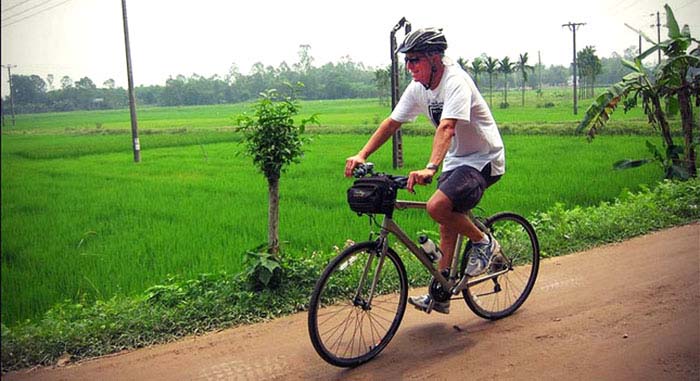
Cycling tour outside of Hue, Vietnam
![]() Hue features pleasant cycling within town and into the scenic countryside, an ideal way to visit the tombs and enjoy riding on footpaths closed to motor traffic. Mostly flat cycling here is along quieter roads and village footpaths, mostly flat with short rollers. A short orientation on "riding the Vietnamese way" will be organized prior to heading out onto the boulevards, though we encourage anyone with trepidation to shuttle out of town by van before mounting their bike. Today's riding is from one hour, to a full-day sightseeing by bike, per your preference, with our support van always nearby.
Hue features pleasant cycling within town and into the scenic countryside, an ideal way to visit the tombs and enjoy riding on footpaths closed to motor traffic. Mostly flat cycling here is along quieter roads and village footpaths, mostly flat with short rollers. A short orientation on "riding the Vietnamese way" will be organized prior to heading out onto the boulevards, though we encourage anyone with trepidation to shuttle out of town by van before mounting their bike. Today's riding is from one hour, to a full-day sightseeing by bike, per your preference, with our support van always nearby.
Along the Perfume River
The Perfume River (Huong Giang) is named after a scented shrub that reportedly grows at its source. There's nothing perfumed about the river in Hue itself-still, a languid half-day on the river is one of the pleasures of Hue.
A sample itinerary follows this route: Trang Tien Bridge to Thien Mu Pagoda to Dien Hon Chen Temple to Tu Duc Tomb to Minh Mang Tomb to Trang Tien Bridge. Some tours skip Hon Chen Temple, and may cover Tu Duc Tomb on land. Tours from Century Riverside Inn cover a three- to four-hour journey by boat to Minh Mang Tomb, then to Ban Lang on the east bank where passengers transfer to a waiting car. Passengers then cover inland tombs by auto on the way back to Hue. The tomb of Khai Dinh is two kilometers from the Perfume River.
If we want longer on the river, we can move on to Gia Long Tomb, farther south on the Perfume River. Gia Long Tomb ' is about 16 kilometers from Hue. The tomb, built between 1814 and 1820, was damaged by bombing during the Vietnam War, and is today overgrown with bushes.
Nightlife
Hue is quiet at night. Entertainment consists mainly of going to restaurants or cafes, though some hotels have dance floors. There's a possible venue for water puppetry shows near Phu Xua Bridge, on the south side. Night cruises on the Perfume River are heavily promoted-these 1.5 hour tours come complete with a crew of half a dozen Hue folk singers who serenade we as we glide along. With luck we can see locals night fishing by lantern-light from sampans.
When to Go?
Hue is typically cool and foggy, with consistent rainfall, but still pleasant and strikingly beautiful. Rain is heavy between August and October; the rainy season extends May-December. That leaves a dry season January-May.
